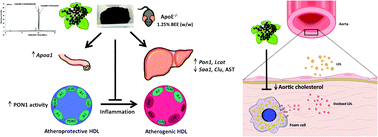Anthocyanin-rich black elderberry extract improves markers of HDL function and reduces aortic cholesterol in hyperlipidemic mice
Abstract
Serum high-density lipoprotein-cholesterol (HDL-C) is a risk factor considered to be protective of atherosclerosis. However, atherosclerosis is an inflammatory disease and contributes to impairment in high-density lipoprotein (HDL) function, including reductions in HDL-C, HDL antioxidant and anti-inflammatory activities. Anthocyanins are polyphenols that have demonstrated antioxidant and anti-inflammatory properties. The objective of this study was to determine whether an anthocyanin-rich black elderberry extract (Sambucus nigra) (BEE) (13% anthocyanins) would protect against inflammation-related impairments in HDL function and atherosclerosis in apoE−/− mice, a mouse model of hyperlipidemia and HDL dysfunction. We fed an AIN-93M diet supplemented with 1.25% (w/w) BEE or control diet to 10 week old male apoE−/− mice for 6 weeks. The BEE fed to mice was rich in cyanidin 3-sambubioside (∼9.8% w/w) and cyanidin 3-glucoside (∼3.8% w/w). After 6 weeks, serum lipids did not differ significantly between groups, while aspartate transaminase (AST) and fasting glucose were reduced in BEE-fed mice. Hepatic and intestinal mRNA changes with BEE-feeding were consistent with an improvement in HDL function (Apoa1, Pon1, Saa1, Lcat, Clu) and a reduction in hepatic cholesterol levels (increased Ldlr and Hmgcr, reduced Cyp7a1). In BEE-fed mice, serum paraoxonase-1 (PON1) arylesterase activity was significantly higher. In addition, mice fed BEE had significantly lower serum chemokine (C–C motif) ligand 2 (CCL2) compared to control-fed mice. Notably, we observed significant reductions in total cholesterol content of the aorta of BEE-fed mice, indicating less atherosclerosis progression. This study suggests that black elderberry may have the potential to influence HDL dysfunction associated with chronic inflammation by impacting hepatic gene expression.



 Please wait while we load your content...
Please wait while we load your content...